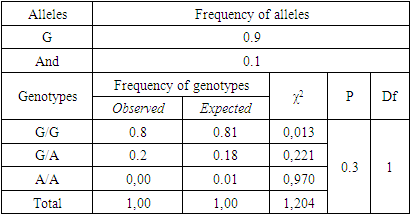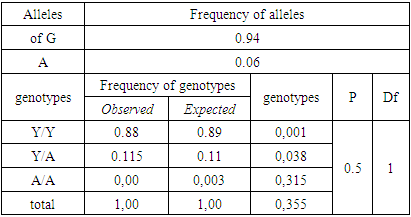-
Paper Information
- Next Paper
- Previous Paper
- Paper Submission
-
Journal Information
- About This Journal
- Editorial Board
- Current Issue
- Archive
- Author Guidelines
- Contact Us
American Journal of Medicine and Medical Sciences
p-ISSN: 2165-901X e-ISSN: 2165-9036
2024; 14(5): 1401-1403
doi:10.5923/j.ajmms.20241405.55
Received: Apr. 22, 2024; Accepted: May 12, 2024; Published: May 23, 2024

Comparative Analysis of the Divergent and Contradictory Data Obtained on the Evaluation of the Relationship Between the Rs1544410 Polymorphism of the DRD4-a Gene and Nocturnal Enuresis
Yusupov Alimardon Mirzaevich1, Djurabekova Aziza Takhirovna2, Kayumova Mohinur Bakhtiyar Kizi1
1Basic Doctoral Student of the Department of Neurology, Samarkand State Medical University, Uzbekistan
2Doctor of Medical Sciences, Professor of the Department of Neurology, Samarkand State Medical University, Uzbekistan
Copyright © 2024 The Author(s). Published by Scientific & Academic Publishing.
This work is licensed under the Creative Commons Attribution International License (CC BY).
http://creativecommons.org/licenses/by/4.0/

Unfavourable ecological, economic, political and social factors of human interaction with the environment, constant increase of neuropsychic tension adversely affect the state of physical and mental capabilities of a person, contribute to the formation of personal maladaptation, leading to the formation of neurotic states, which, in turn, interfere with the processes of optimal life activity.
Keywords: Comparative analysis, Contradictory data, Polymorphism, Nocturnal enuresis
Cite this paper: Yusupov Alimardon Mirzaevich, Djurabekova Aziza Takhirovna, Kayumova Mohinur Bakhtiyar Kizi, Comparative Analysis of the Divergent and Contradictory Data Obtained on the Evaluation of the Relationship Between the Rs1544410 Polymorphism of the DRD4-a Gene and Nocturnal Enuresis, American Journal of Medicine and Medical Sciences, Vol. 14 No. 5, 2024, pp. 1401-1403. doi: 10.5923/j.ajmms.20241405.55.
1. Introduction
- Children of adolescence represent a high-risk group. During this period, active changes in hormonal status occur and a mature and independent personality is formed. Excessive tension of the mental sphere and violation of the mechanisms of social adaptation lead to increased anxiety, decreased self-control, irresponsibility, unscrupulousness, cruelty and aggressiveness, consolidation of unfavourable traits in the formation of personality [2] Lack of timely psychological help to such children contributes to the development of neuroses, deviant and addictive behaviour [6].Various forms of mental maladaptation are noted in 83 per cent of older girls and 62 per cent of boys. They include prenosological, initial mental health disorders. These functional states on the verge of norm and pathology have an independent significance for the hygiene of children and adolescents in terms of assessing their impact on the child's development and improving primary prevention measures [4]. It is the prenosological states that are the main forms of mental health disorders of schoolchildren [3]. The reasons for the development of deviant forms of behaviour are not only environmental and social factors, but also genetic predisposition [1]. According to modern research, the differences between people in basic psychological characteristics are equally determined by the influence of genes and the external environment [7]. With unfavourable influence of both factors on character development, high degrees of deviation, up to pathological forms, may develop. With a favourable combination, even a strong genetic predisposition to the development of abnormality may not be realized or at least not lead to pathological character deviations [8]. According to modern psychogenetic concepts of personality development, the features of human behaviour are implemented through the interaction of CNS neurotransmitters, the most important of which are dopamine, serotonin and noradrenaline [10]. Currently, there is a large number of studies devoted to the study of the relationship of neurotransmitter gene polymorphisms with the peculiarities of human behaviour and personality.The aim of the study was to investigate the frequency of alleles and genotypes distribution of polymorphic markers of DRD4-a gene (rs1544410) in the group of NE patients and conditionally healthy donors (control sample).
2. Materials and Methods of the Study
- A total of 93 patients with HE (main group) were examined. This group of patients was divided into 2 subgroups depending on the severity of the disease:1. NE patients (n=45);2. Patients with enuresis (n=48).The control sample consisted of 93 conditionally healthy donors from Uzbekistan.The frequency distribution of alleles and genotypes of polymorphic marker rs1544410 of DRD4-α gene in the main group and subgroups of EI patients and control sample was analysed. The cytokine gene DRD4-α is located at the 6p21.1-6p21 locus.3. The coupling map of the main human histocompatibility complex containing the genes of tumor necrosis factors ProcNatlAcadSciUSA 84: 8535–8539 doi:10.1073/pnas.84.23.8535 has identified several functional polymorphic loci to date (-863, -857, -850, -575, - 375, -74, -308, -237, -162), among which the most important is the option of replacing guanine with adenine G-308A. The international polymorphism code is rs1544410.The allele variant 308A of this gene affects the level of mRNA transcription and, accordingly, the biosynthesis of this cytokine in the body. (Wilson A.G., di Jovin F.S., Blakemore A.I. and Duff G.V., "Single-base polymorphism in the tumor necrosis alpha factor gene can be detected using NcoI restriction of PCR product", Human Molecular Genetics, Volume 1, No. 5, 1992, p. 353. doi:10.1093/hmg/1.5.353, Wilson A.G., Symons J.A., McDowell T.L., McDevitt G.W, Duf, H.O., 1997a. The effect of polymorphism in the promoter of human tumor necrosis factor alpha on transcription activation. Proc. Natl. Acad. Sci. 94, 3195–3199. DOI: 10.1073/pnas.94.7.3195; Wilson, A.G., Symons, J.A., McDowell, T.L., McDevitt, H.O., Duff, J.W., 1997b. The effect of polymorphism in the promoter of human tumor necrosis factor-α on transcription activation. Proc. Natl. Acad. Sci. U.S. A. 94, 3195–3199.). The distribution of alleles and genotypes of the DRD4-α rs1544410 gene in the study groups of patients in the main and control groups was checked by the Hardy-Weinberg equilibrium.Tables 1 and 2 present the theoretical and actual (Hexp and Obs, respectively) frequencies of alleles and genotypes, as well as indicators of gene diversity in the primary and control samples of patients. The frequencies of the G and A alleles in the studied patients and the control group were 0.82/0.18 and 0.90/0.1, respectively.Analysis of the distribution of genotypic variants of the DRD4-α rs1544410 gene showed that the actual distribution of genotypes in the groups of TE patients and controls for this polymorphism corresponded to the theoretically expected Hardy-Weinberg equilibrium (p < 0.05).
|
|
|
3. Conclusions
- Thus, the polymorphism rs1544410 of the DRD4-a gene is one of the main reasons for the insufficient regulation of the inflammatory and immune response of the body, and according to our data, the foreign variant G/A (associated with the overproduction of proinflammatory cytokines TNF). It is interesting to note that the negative effect of this genotype was observed only in patients with Enuresis, whereas the frequency of this genotype in patients with NPDR did not differ compared to the control group, that is, there is a tendency to increase the severity of pathology in the genotype. Since this study is one of the few studies on the association of rs1544410 of the DRD4-a gene with the risk of developing NE, our data may be the subject of further discussion.
 Abstract
Abstract Reference
Reference Full-Text PDF
Full-Text PDF Full-text HTML
Full-text HTML

